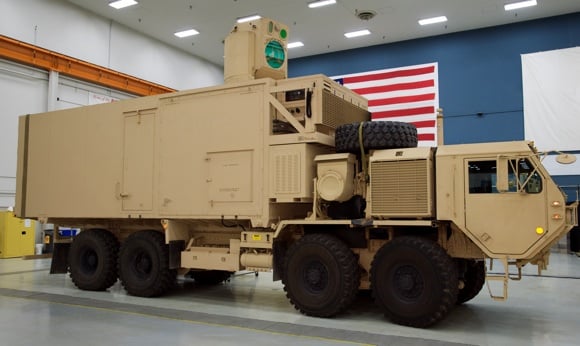This article is more than 1 year old
Army raygun to boost power with starlight de-twinkling tech
Cool astronomer tool to make laser blasts extra hot
The US Army, in the process of building an enormous raygun on a lorry, has decided that it will enhance its laser cannon of the future by the use of adaptive optics - a crafty technology employed in telescopes by astronomers to eliminate the effects of the atmosphere on starlight.
Under the High Energy Laser Technology Demonstrator (HEL-TD) programme, however, adaptive optics will be used to prevent atmospheric distortions from affecting the ravening blasts emitted from the weapon and reducing their effects on the enemy as they otherwise would.
"By minimizing the distortion of a laser beam - much like telescopes can take the ‘twinkle’ out of the stars - we can increase the amount of energy on a specific target. This very small, lightweight Adaptive Optic system will enhance both the range and the power of tactical laser weapons," boasts Mike Rinn of US weapons behemoth Boeing, working for the US Army on HEL-TD.
Astronomers cheesed off by twinkly stars use kit that measures distortion of incoming light very fast and employs piezoelectric actuators to warp the shape of a telescope mirror to tolerances of one fifty-thousandth of a millimetre every millisecond. This lets the mirror produce an image approaching theoretical perfect performance.

The raygun lorry is still fairly heavy, obviously.
In this case the idea is not to produce a perfect image on the display of a telescope but to deliver a perfect high-energy beam onto such targets as a flying artillery shell or mortar bomb, so causing it to explode harmlessly in mid-air. Aiming a laser beam through air, while potentially easier than aiming a ballistic projectile, can be tricky (as is obvious when one remembers looking though heat haze or skyward at twinkly stars).
Quite apart from use in combat beams, US military boffins have also recently applied adaptive optics with good effect to communications lasers - reportedly to the point where beams through the air become as clear as ones carried by fibre, not only boosting bandwidth hugely but perhaps allowing the use of quantum crypto methods in which single photons are used to convey keys.
If adaptive optics can have a similar effect on HEL-TD, the day of the practical combat raygun may arrive sooner than had been expected. ®
